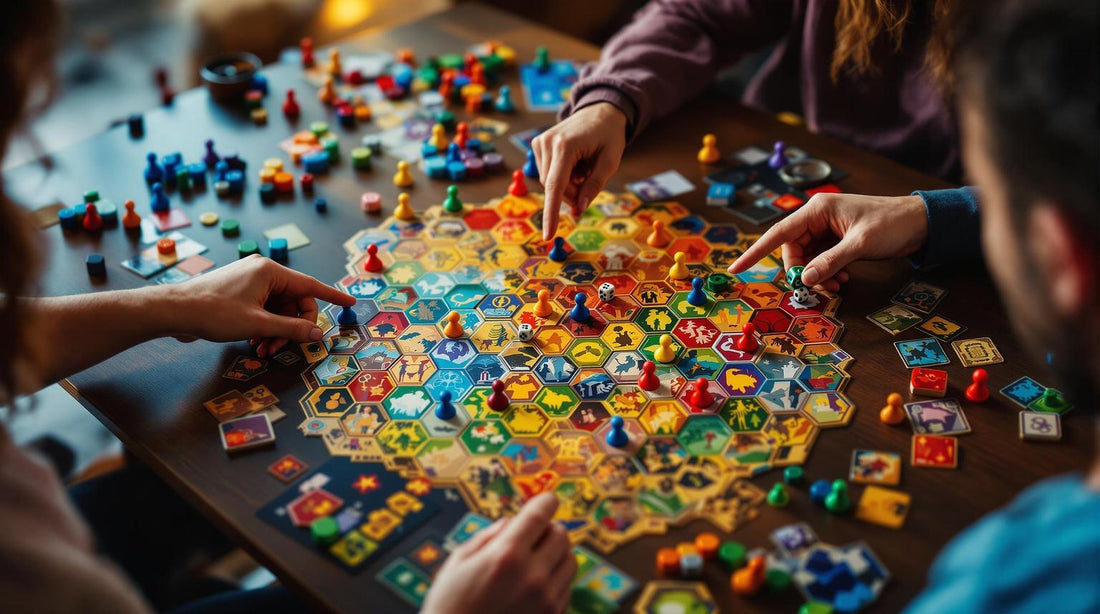Discover the Best Board Games for Every Player

What Are Interrupt Mechanics in Board Games?
Interrupt mechanics let players react during their opponents' turns, adding real-time decision-making to turn-based games. These mechanics keep players engaged, enhance strategy, and create dynamic gameplay. However, they can also slow down the game if not well-designed.
Key Points:
- How They Work: Players can respond to actions mid-turn (e.g., Lord of the Rings: SBG, DUST Tactics).
- Benefits: Add strategy, realism, and engagement.
- Challenges: Can cause slower gameplay or analysis paralysis.
- Solutions: Use phase-specific triggers, resource limits, and clear rules.
Quick Comparison:
| Game | Interrupt Feature | Impact |
|---|---|---|
| Lord of the Rings: SBG | Phase-based reactions | Tactical depth without slowing gameplay |
| DUST Tactics | Command phase system | Balances actions and reactions strategically |
| Osprey's Black Ops | Suppression fire as reaction | Mirrors combat scenarios, maintains tempo |
Interrupt mechanics, when balanced, can elevate the gaming experience by blending strategy with interaction. The challenge is ensuring they enhance the flow without overcomplicating gameplay.
Core Mechanics of Interrupts
When Interrupts Happen
Interrupts in games are key moments where players can respond to unfolding situations. In Lord of the Rings: SBG, these occur naturally within the game's five-phase turn structure. Each phase - movement, shooting, and simultaneous melee combat - lets players react strategically to their opponent's moves without breaking the flow.
In DUST Tactics, interrupts work differently. The game divides turns into command and unit phases. During the command phase, players spend orders to activate units, while the unit phase allows for both actions and reactions. This system pushes players to carefully weigh immediate actions against conserving resources for later.
Some games tie interrupts directly to their themes. For example, Osprey's Black Ops uses suppression fire as a reaction mechanic. This mirrors real-world combat scenarios, letting players disrupt their opponents while maintaining the game's tempo. These moments are carefully designed to fit the game's style and ensure smooth gameplay.
Interrupt Limits and Controls
To keep gameplay balanced and engaging, designers set boundaries on how and when interrupts can be used. These limits prevent games from becoming sluggish or overly chaotic.
| Game | Interrupt Limitation | Strategic Impact |
|---|---|---|
| DUST Tactics | Units lose an action when reacting | Encourages players to think carefully about timing |
| Lord of the Rings: SBG | Reactions are phase-specific | Maintains tactical depth without slowing the game |
| Osprey's Black Ops | Suppression fire as a reaction mechanic | Forces trade-offs between offense and defensive reactions |
These examples highlight how constraints keep games exciting and strategic. In DUST Tactics, for instance, losing an action when reacting forces players to decide if an interrupt is worth the cost.
"The key to successful interrupt mechanics is finding a balance between interaction and game speed. Too many reaction points can slow down the game, while too few may make it feel static."
Modern game design often integrates these controls into existing systems, like resource management or action economies. Instead of layering on extra rules, designers use these built-in mechanics to ensure interrupts add depth without overwhelming the gameplay.
Game Design with Interrupts
Making Interrupts Simple to Use
Interrupt mechanics in games should add strategic depth without confusing players. One way to achieve this is by using a structured turn system. For instance, some games rely on multi-phase turns to clearly indicate when interrupts can occur. DUST Tactics is a great example - it separates gameplay into command and unit phases, making it clear when players can react.
Breaking down complex interrupt systems into smaller, more digestible parts also helps players, especially newcomers, understand the mechanics. By defining specific moments for reactive actions, designers can avoid overwhelming players with too many options.
| Design Element | Implementation | Player Benefit |
|---|---|---|
| Phase Structure | Dividing turns into clear segments | Makes interrupt opportunities easy to follow |
| Resource Management | Command pools for actions | Encourages thoughtful decisions without chaos |
| Reaction Timing | Phase-specific interrupt triggers | Creates predictable and fair response windows |
These design choices create a solid framework for integrating interrupts into games, ensuring they feel intuitive and engaging.
Games That Use Interrupts Well
Some games handle interrupts in a way that feels natural and enhances gameplay. For example, Pulp Alley uses a flexible initiative system. The active player determines the turn order, which naturally opens up chances for strategic interruptions while keeping the game smooth.
In X-COM, interrupts are introduced through its overwatch system. This allows players to set up defensive reactions during enemy movement, adding tension and strategy.
Board game adaptations of Dungeons & Dragons provide a scalable approach to interrupts. Early scenarios keep reaction mechanics simple, while advanced modules gradually introduce more complex options as players gain experience.
Here are some key tips for designing effective interrupts:
- Limit the number of interruptions per turn to avoid slowing down gameplay.
- Tie interrupts to existing resource systems to encourage strategic use.
- Use clear visual cues or components to signal interrupt opportunities.
- Ensure interrupts enhance the game’s flow rather than disrupt it.
sbb-itb-1ed942f
Pros and Cons of Interrupts
What Interrupts Add to Games
Interrupts bring an extra layer of strategy by enabling real-time reactions. They shift turn-based gameplay into something more dynamic and interactive. For example, in Lord of the Rings: SBG, interrupts create tension and force players to make thoughtful decisions.
Here’s how interrupts can positively impact gameplay:
| Benefit | Effect on Gameplay | Example Implementation |
|---|---|---|
| Strategic Planning | Encourages players to think ahead for actions and reactions | DUST Tactics' command phase system |
| Player Engagement | Keeps players involved, even during opponent turns | Pulp Alley's flexible initiative system |
| Tactical Realism | Mimics real-world combat reactions | Lord of the Rings: SBG's combat phases |
| Dynamic Gameplay | Introduces unexpected and exciting moments | Infinity's line-of-sight reaction system |
By allowing players to react in real time, interrupts keep everyone engaged and contribute to a more immersive experience. However, they’re not without their challenges.
Common Problems with Interrupts
Despite their advantages, interrupt systems can also cause issues if not carefully designed. One major drawback is longer playtime. If every action can lead to a reaction, players may spend extra time weighing their choices, which can slow the game.
Another issue is analysis paralysis. When players have too many options for interruptions, they might overthink, disrupting the game’s pacing. This is especially true in games where multiple interruptions are possible in a single turn.
To address these challenges, successful games often use these strategies:
1. Phase-Based Structure
Breaking gameplay into clear phases simplifies when and how interrupts can occur, reducing confusion and keeping the game moving.
2. Limited Resources and Triggers
Tying interrupts to limited resources or specific triggers helps streamline decision-making and prevents overuse, maintaining the game's flow.
Where to Buy Games with Interrupts
Now that we've covered interrupt mechanics, here's where you can find games that use these engaging features.
Brain Games Selection

Brain Games offers a wide range of board games with interrupt mechanics, catering to all skill levels - from beginners to seasoned strategists. Each game listing includes detailed descriptions, making it easy to identify how interrupts are integrated. If you're just starting, consider Black Ops by Osprey, which uses a straightforward suppression fire interrupt system.
| Game Complexity | Recommended Titles | Interrupt Features |
|---|---|---|
| Beginner | Black Ops | Simple suppression mechanics |
| Intermediate | DUST Tactics | Command phase system |
| Advanced | Games mentioned earlier | Multi-phase interrupts |
| Expert | Infinity | Complex reaction system |
Why Choose Brain Games?
Brain Games provides a 14-day exchange policy, so if a game's interrupt mechanics don't suit your preferences, you can easily swap it. For games with special components like interrupt-related tokens or cards, their direct publications come with a lifetime component guarantee.
Their website is packed with helpful resources, including detailed product descriptions, customer reviews, and expert support to answer your questions about game mechanics. You can explore their collection of interrupt-based games online at Brain-Games.com or Brain-Games.lv/en/.
Summary
Interrupt mechanics add a layer of real-time decision-making to turn-based games, allowing players to react dynamically during gameplay. This approach enhances both strategy and immersion.
Games incorporate interrupts in different ways, ranging from straightforward reactions to more intricate, phase-based systems. As mentioned earlier, having clear rules and resource limits is key to keeping these mechanics effective without disrupting the game’s pace. When designed well, interrupts add depth and keep players engaged. On the flip side, poorly executed systems can bog down the game and make it unnecessarily complicated.
This concept highlights the importance of interrupts in creating a richer strategic experience. The challenge lies in striking the right balance - keeping the game flowing smoothly while offering players meaningful choices. Thoughtful use of these mechanics continues to influence modern board game design, giving players more interactive and engaging gameplay options.






